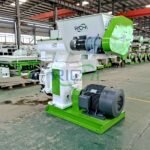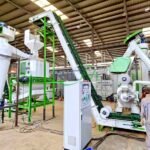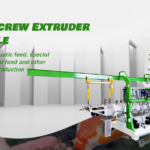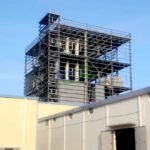Wood pellet maker machines are essential in the biomass industry, converting raw materials into high-density pellets used for energy production, animal bedding, and other applications. The efficiency of these machines significantly impacts the overall production costs, influencing profitability and competitiveness in the market. This article explores the various ways in which the production efficiency of wood pellet maker machines affects costs, including raw material utilization, operational expenses, labor costs, and maintenance.
1. Raw Material Utilization
One of the most significant factors influenced by the efficiency of wood pellet maker machines is the utilization of raw materials.
- High Efficiency and Yield: Efficient wood pellet machines maximize the conversion of raw materials into pellets, resulting in higher yields. When machines operate at optimal efficiency, they can produce more pellets from the same quantity of raw materials, reducing the cost per ton of pellets produced. For instance, a machine with a production capacity of 1 ton per hour that operates at 90% efficiency will yield 0.9 tons of pellets, while one operating at 70% efficiency will yield only 0.7 tons. This difference can significantly impact the overall production costs.
- Minimizing Waste: Efficient machines minimize waste during the production process. When raw materials are not effectively converted into pellets, it leads to increased waste and higher costs associated with disposal or recycling. By optimizing the use of raw materials, producers can reduce their input costs and improve their profit margins.
2. Operational Expenses
The operational efficiency of wood pellet maker machines directly influences various operational expenses, including energy consumption, labor costs, and overall production time.
- Energy Consumption: Energy costs are a significant portion of the operational expenses in pellet production. Efficient machines consume less energy per ton of pellets produced. For example, a high-efficiency pellet mill may require 30% less energy to produce the same amount of pellets compared to a less efficient model. This reduction in energy consumption translates to lower utility bills, improving the overall cost-effectiveness of the production process.
- Labor Costs: The efficiency of wood pellet machines can also affect labor costs. Machines that operate efficiently often require less manual intervention and monitoring, allowing operators to manage multiple machines simultaneously. This increased automation can lead to a reduction in labor costs, as fewer workers are needed to oversee the production process. Additionally, efficient machines typically have shorter production cycles, enabling producers to meet demand more quickly and effectively.

3. Maintenance and Downtime
The maintenance requirements and downtime of wood pellet maker machines are critical factors that can impact overall production costs.
- Reduced Maintenance Needs: High-efficiency machines are often designed with advanced technology and durable materials, leading to lower maintenance requirements. Machines that operate efficiently tend to experience less wear and tear, resulting in fewer breakdowns and repairs. This reduction in maintenance needs can lead to significant cost savings over time, as producers spend less on parts and labor for repairs.
- Minimized Downtime: Downtime can be costly for pellet producers, as it halts production and affects the ability to meet customer demands. Efficient machines are less prone to breakdowns and can maintain consistent production levels, minimizing downtime. This reliability ensures that producers can operate at full capacity, maximizing their output and revenue potential.
4. Initial Investment and Return on Investment (ROI)
While the initial investment in high-efficiency wood pellet maker machines may be higher than that of standard machines, the long-term benefits can justify the cost.
- Higher Initial Costs: High-efficiency machines often come with advanced features and technology, resulting in a higher upfront cost. However, producers must consider the potential for increased production efficiency, lower operational costs, and reduced maintenance expenses over the machine’s lifespan.
- Improved ROI: The increased efficiency of wood pellet maker machines can lead to a faster return on investment (ROI). By producing more pellets in less time and at a lower cost, producers can recoup their initial investment more quickly. Additionally, the ability to produce high-quality pellets consistently can lead to higher sales prices and increased market competitiveness.
5. Market Competitiveness
In a competitive market, the efficiency of wood pellet maker machines can significantly influence a producer’s ability to compete.
- Pricing Strategies: Producers who operate high-efficiency machines can offer competitive pricing while maintaining healthy profit margins. The ability to produce pellets at a lower cost allows them to respond to market fluctuations and remain competitive against other suppliers.
- Quality Assurance: Efficient machines often produce higher-quality pellets with better density and durability. This quality assurance can enhance customer satisfaction and loyalty, leading to repeat business and positive word-of-mouth referrals. (Related post:wood pellet press for sale)
Conclusion
The production efficiency of wood pellet maker machines plays a crucial role in determining the overall costs associated with pellet production. From optimizing raw material utilization and reducing operational expenses to minimizing maintenance needs and enhancing market competitiveness, the efficiency of these machines directly impacts profitability.
Investing in high-efficiency wood pellet machines may require a higher initial capital outlay, but the long-term benefits, including lower production costs and improved ROI, can make them a worthwhile investment. As the demand for renewable energy sources and sustainable practices continues to grow, the importance of efficient wood pellet production will only increase.
By understanding the relationship between production efficiency and costs, producers can make informed decisions about their machinery investments, ultimately leading to a more sustainable and profitable pellet production operation.






